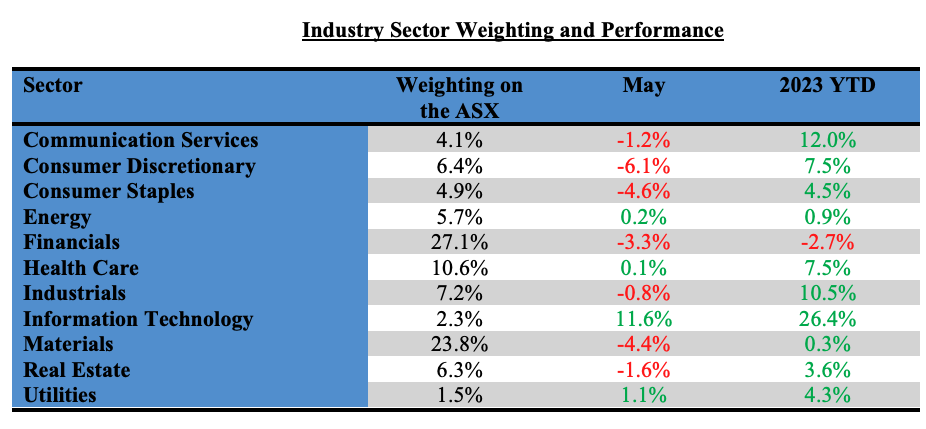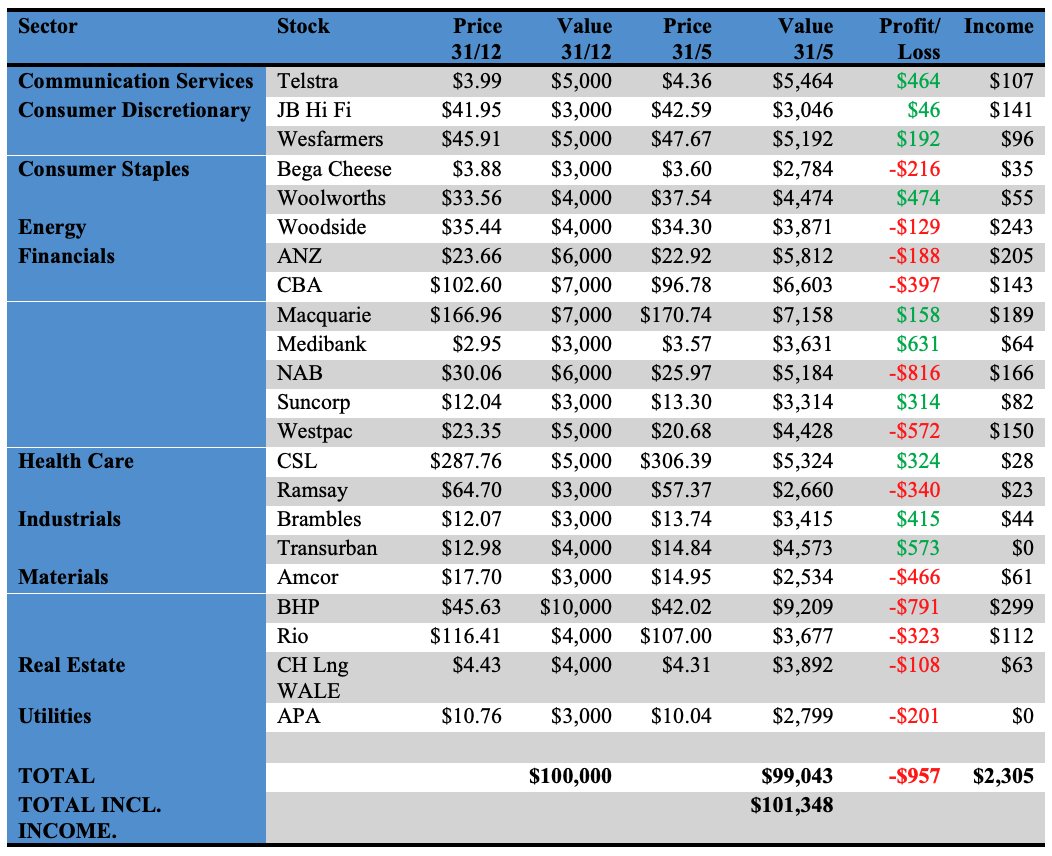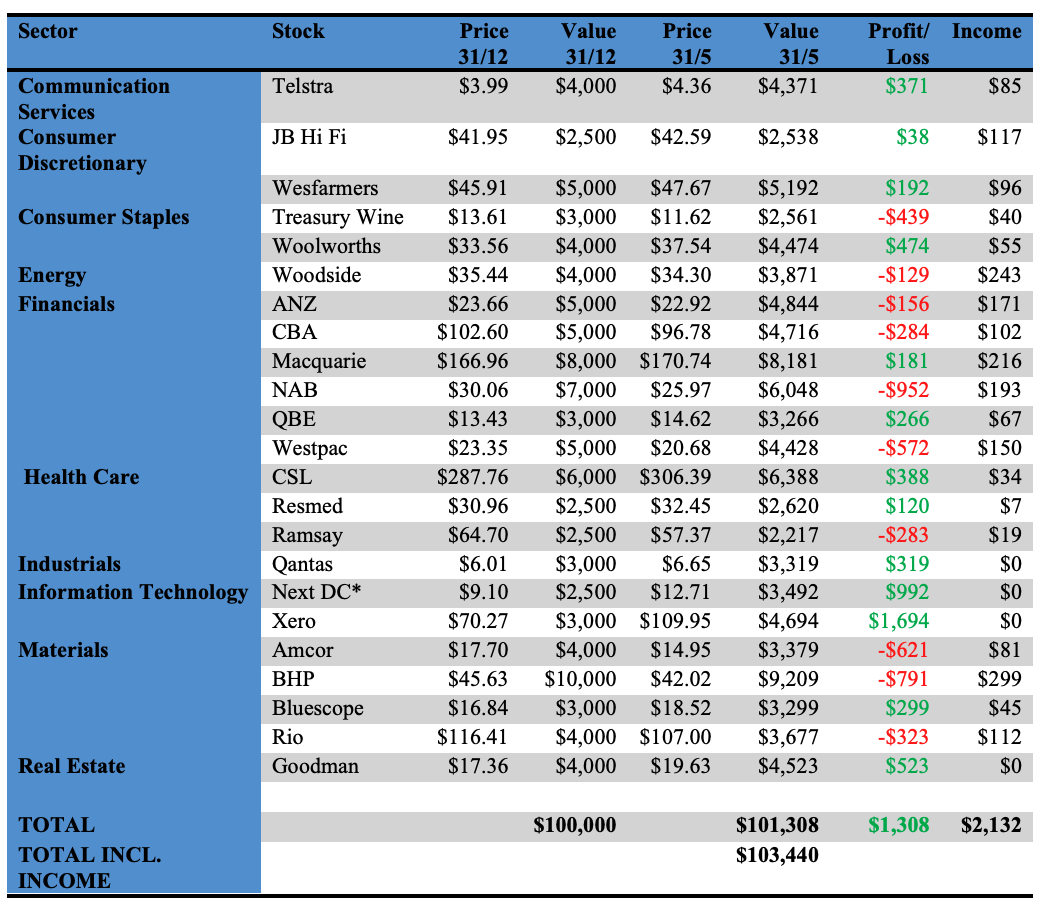The Australian share market fell in May losing almost 3.0% in price terms. In 2023, it is up by a modest 0.75% or 2.71% when dividends are included.
Our model portfolios retreated in May but are in the black for 2023. The growth portfolio continues to outperform the benchmark index, while the income portfolio, with an overweight position in financial stocks, is lagging the benchmark.
There are two model portfolios – an income-oriented portfolio and a growth portfolio.
The objectives, methodology, construction rules and underlying economic assumptions can be referenced here: (see: https://switzerreport.com.au/our-portfolios-for-2023/
These are long-only model portfolios, and as such, they are assumed to be fully invested at all times. They are not “actively managed”, although adjustments are made from time to time.
In this article, we look at how they have performed so far in 2023. To do so, we will start by examining how the overall market has fared.
IT stocks lead as the heavyweight financials and materials sectors come under pressure
The tables below show the performances in May and for the calendar year for the components and industry sectors that make up the Australian share market.
In May, the top 20 stocks, which are dominated by the major banks and big miners, underperformed losing 3.2%. In comparison, the midcap 50 stocks (stocks ranked 51st to 100th by size of market capitalization) posted a flat result. Small caps, which are stocks ranked 101st to 300th by market capitalization, also fell.

With the industry sectors, information technology is the standout sector. Following on the lead from the USA, the sector has posted a gain of 26.4% in 2023 due to the performances of industry leaders such as WiseTech, NextDC and Xero.
The two largest sectors, financials and materials, are the relative laggards. Financials, which makes up 27.1% by weighting, lost 3.3% in May due to disappointing major bank profit results and is in the red for the year. The second largest sector, materials, is only moderately positive, with the big miners being hurt r by softening commodity prices.
The consumer facing sectors, which had started 2023 with solid gains, been winners in 2023, suffered losses in May. Concerns about a slowing economy, plus the RBA’s surprise increase to the cash rate, hurt sentiment. The consumer discretionary sector lost 6.1% in May but is still up 7.5% in 2023.

Portfolio performance in 2023
The income portfolio to 31 May has returned 1.35% and the growth-oriented portfolio has returned 3.44% (see tables at the end). Compared to the benchmark S&P/ASX 200 Accumulation Index (which adds back income from dividends), the income portfolio has underperformed by 1.36% and the growth portfolio has outperformed by 0.73%.

Income portfolio
The objective of the income portfolio is to deliver tax advantaged income whilst broadly tracking the S&P/ASX 200.
The income portfolio is forecast to deliver an income return of 5.0% (based on its opening value at the start of the year), franked to 80.3%. With dividends declared during the February reporting season marginally better than forecast, it is on track to meet this. Year to date, the income return is 2.31% franked to 87.5%.
In the month of May, the income portfolio returned -3.19%. This underperformed compared to the benchmark index by approximately 0.66%. For the year, it has returned 1.35%, which is 1.36% behind the index.
The portfolio is moderately overweight financial stocks and underweight the more growth-oriented sectors such as information technology and health care. In a strong bull market, the income portfolio will typically lag the market, and in a bear market, it is likely to outperform.
No changes to the portfolio are proposed at this point in time.
The income biased portfolio per $100,000 invested (using prices as at the close of business on 31 May 2023) is as follows:

Growth portfolio
The objective of the growth portfolio is to outperform the S&P/ASX 200 market over the medium term, whilst closely tracking the index.
In May, the growth portfolio returned -2.82%, underperforming the benchmark index by 0.29%. Year to date, it has returned 3.44%, outperforming the benchmark by 0.73%. (Note: performance does not include potential participation in NextDC 1:8 non renounceable entitlement issue at $10.80 per share).
The portfolio is moderately overweight financials, health care and information technology. It is moderately underweight industrials, real estate and utilities. Overall, the sector biases are not strong.
Treasury Wine Estates and Ramsay Health Care were sold down in May, but we propose to maintain both holdings. No changes are proposed to the portfolio at this point in time.
Our growth-oriented portfolio per $100,000 invested (using prices as at the close of business on 31 May 2023) is as follows:

* Performance does not include participation in 1:8 non-renounceable issue at $10.80 per share
Important: This content has been prepared without taking account of the objectives, financial situation or needs of any particular individual. It does not constitute formal advice. Consider the appropriateness of the information in regards to your circumstances.

